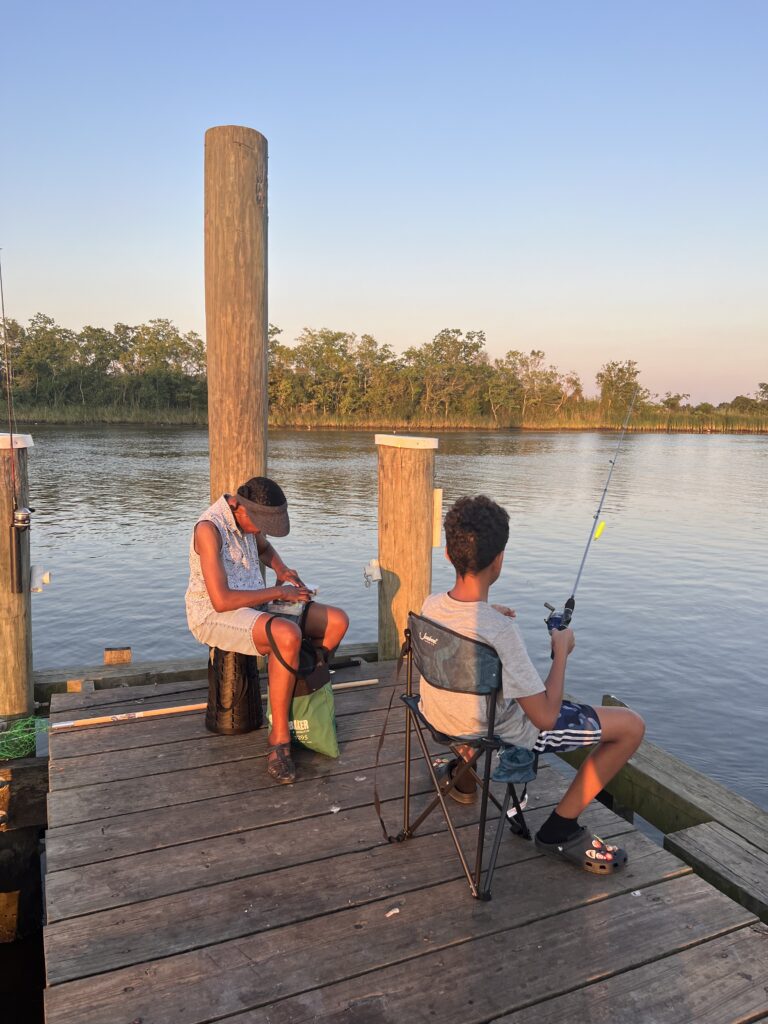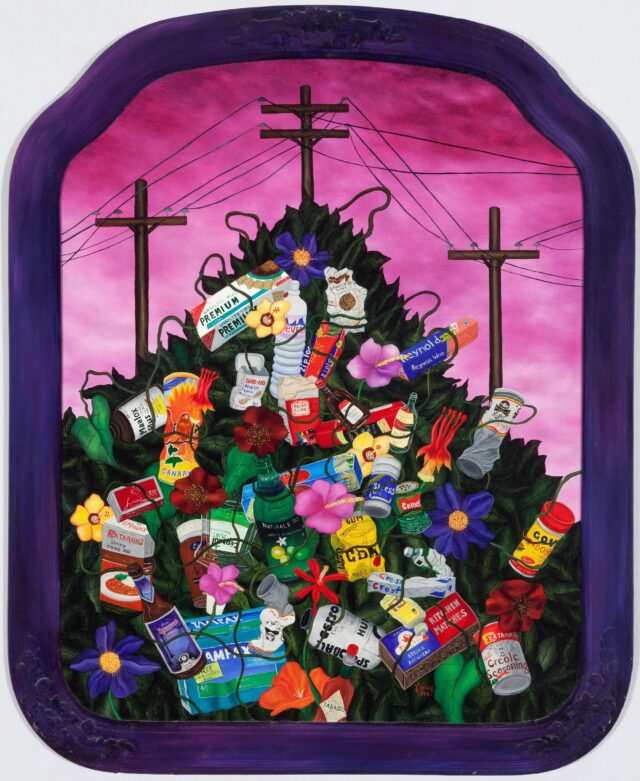Jacqueline Bishop displays a mountain of consumer products intertwined with the surrounding hill of leaves, flowers and vines. These products are mainly related to kitchen supplies and ingredients for Creole and Cajun cooking but include other products associated everyday life of a young woman, such as Crest toothpaste, matches, a pack of Tampax, and an empty Dixie’s Blackened Voodoo beer. The hill of trash, vines, and flowers overtakes most of the scene that Bishop allows us to see of her world. Our only peek at what exists beyond is the ominous clouds consuming the gradient pink sky gradually softening where the skyline touches the hill. Three powerline posts resurrect behind the mountain in the distance amidst the cloudy skyline with the center post connected to the the others via powerlines. Their positioning reminds me of the three crosses, I learned about as a child, that were ready for Jesus and two other prisoners for their crucifixion. Bishop’s world apparently still needs salvation.
Bishop often produces work dealing with eco-political injustice throughout Louisiana’s swamplands and the Global South yet this depiction of humankind’s lost intimacy with nature points to the contributions of the Americanization of South Louisiana in Louisiana Mountain: Decadence (Kemp, 2016). By the use of the term “Americanization”, I am referring to the process by which the United States government spread the political philosophy of melding “America’s many cultural and ethnic groups into ‘one nation, one people’” led by former president Theodore Roosevelt (Ancelet, 2007, p. 1238). This process initiated the erasure of French Creole and Cajun ways of living and language that has forced Anglo-American traditions and language onto communities that have historically existed here for generations, including Indigenous communities, before Louisiana was given statehood in 1812. However, regardless of these attempts, remnants of French culture and ways of life has thrived and continued to be passed down through its subculture of Creole and Cajun culture and cuisine.
As I’ve discussed in previous blog posts, food is a system of communication that exceeds boundaries of linear cycles of storytelling and knowledge (Darton, 2012). Food embodies culture and history and identity wrapped in every bite of what we eat and how we get it. Such food practices, better understood as foodways, also serve as methods to encompass memories of the past. Put in other words, food is a time machine. Yet care for how food is produced and consumed seems to have lost its cultural and social significance in the United States. The process of Americanization that has swept across the US–an experiment that has for the most part been a complete success–has provoked a loss of intimacy with nature.
Bishop’s Louisiana Mountain: Decadence highlights the clash of between the past and the present that is becoming evermore apparent during the 1990s. The American philosophy of oneness has led to the corruption of the soul, although communities throughout South Louisiana continue to resist. Practices such as fishing and hunting, for example, continue to be passed between generations that date back to when European colonists were taught by local Indigenous communities in Acadiana region. I want to emphasize that the knowledge being passed down goes beyond the act of killing these precious animals. Ways in which to use every part of the animal to ensure lack of waste through cooking methods is prevalent in Creole and Cajun cuisine. As I’ve been learning on this beautiful journey to understand who I am and where I am from, everything seems to go back to food. From how my family members define who they are, where they come from, and how they come to these conclusions, all centers around food, and more specifically, what they were being served and the community that surrounds their eating practices.

What Brings Us Together is a project that initially started as an autoethnography of the cultural, economic, and historical landscape in South Louisiana through focusing on my family’s relationship with agriculture and Creole cuisine. However, this autoethnography has turned into a project focusing on the evolution of how Creole and Cajun identity, culture, and cuisine define themselves and, more specifically, what historical, political, and cultural events have led to the modern understandings of these terms. While studying through traditional academic resources has been helpful, the perspective of my family members has been the most insightful as they’ve shared how their understanding contrasts and conforms with these notions. I hope they are proud of the final product as it stands to act as the first iteration of our family archive that will exist as an experimental cookbook filled with interviews of my family and an attempt to recreate family memories through food while looking at the surrounding political, historical, and cultural events in the Acadiana region within South Louisiana.
Ancelet, B. J. (2007). Negotiating the Mainstream: The Creoles and Cajuns in Louisiana. The French Review 80(6), 1235-1255.
Bishop, J. (1991). Louisiana Mountain: Decadence [Painting].
Darnton, J. (2012, December 12). Foodways: When food meets culture and history. Michigan State University Extension.
Kemp, John R. “Jacqueline Bishop” (8 December 2016). 64 Parishes. https://64parishes.org/entry/jacqueline-bishop
